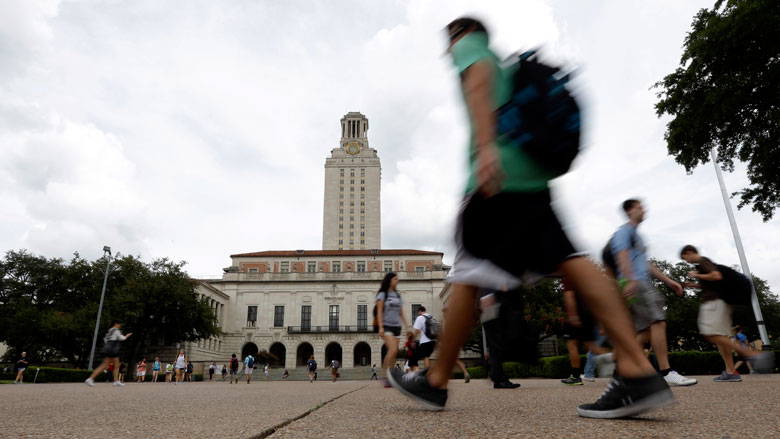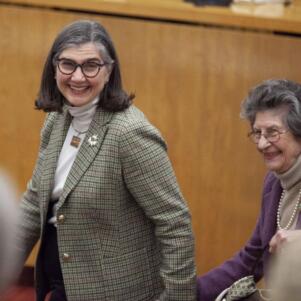The Supreme Court’s affirmative action ruling, explained
By Kevin Daley | June 27, 2016, 6:15 EDT
 Texas students walk past the university’s iconic tower, in Austin. In a 4-3 opinion, a court majority held that Texas had demonstrated its “narrowly tailored” policy of looking at race to fill one-quarter of its freshman classes was necessary because a strictly “nonracial approach” had failed to produce enough student diversity. (AP Photo/Eric Gay)
Texas students walk past the university’s iconic tower, in Austin. In a 4-3 opinion, a court majority held that Texas had demonstrated its “narrowly tailored” policy of looking at race to fill one-quarter of its freshman classes was necessary because a strictly “nonracial approach” had failed to produce enough student diversity. (AP Photo/Eric Gay) Supreme Court Justice Anthony M. Kennedy salvaged the University of Texas at Austin’s (UT) race-conscious admissions policy in Fisher v. University of Texas Thursday, while divulging little about the future of affirmative action as a general constitutional question.
In a 4-3 decision, the Supreme Court upheld carefully designed affirmative action programs as constitutionally acceptable.
UT’s admissions procedure evaluates applicants against two scales: an Academic Index (AI) which measures grades and test scores, and a Personal Achievement Index (PAI) which evaluates extracurricular activities, socioeconomic factors, and race. The two scores are merged to create a single AI/PAI score, which weighs heavily when an admissions decision is made.
A challenge to this process was brought by Abigail N. Fisher, a white female who applied for admission to UT in 2008. Fisher was denied admission, and filed suit against UT, claiming the denial of her application was in part related to racial preferences given to minority applicants.
The case has been heard twice by the high court. In 2013, the justices first heard the case but declined to rule on the merits, remanding it back to a lower court and instructing it to reevaluate the case according to a standard of strict scrutiny in a 7-1 decision. The strict scrutiny test, the most rigorous standard of judicial review, is meant to assess whether a precisely tailored compelling government interest outweighs a constitutional right or principle. Speaking for the Court in Fisher I, Kennedy again affirmed that “campus diversity” is a constitutionally legitimate rationale for employing race-conscious admissions policies, but placed a rigorous test on such methods, writing that universities bear “the ultimate burden of demonstrating, before turning to racial classifications, that available, workable race-neutral alternatives do not suffice.”
These policies, the Court said, may be employed until such time as a university reaches a “critical mass” of minority students sufficient to fulfill its goal of diversity.
Fisher I left several questions unanswered, however. In the first place, it never defined what was meant by “critical mass.” When does a university have enough minority representation to ensure diversity? In the second place, it never made clear what was meant by a “workable” program.
Little clarity as to these key questions was added in Thursday’s opinion.
In Thursday’s decision, Kennedy declined to precisely explain what he meant by “critical mass” of diversity in Fisher I. In Fisher II, he writes “As this Court’s cases have made clear, however, the compelling interest that justifies consideration of race in college admissions is not an interest in enrolling a certain number of minority students. Rather, a university may institute a race-conscious admissions program as a means of obtaining ‘the educational benefits that flow from student body diversity.’”
This is to say that “critical mass” is met when “the educational benefits that flow from student body diversity” are present. Legal observers noted that this test creates a problem. While Kennedy writes that a university’s diversity goals “must be sufficiently measurable to permit judicial scrutiny of the policies adopted to reach them,” it is rather difficult to measure “the educational benefits that flow from student body diversity.” Nonetheless, in this case, Kennedy and the Court’s majority felt UT had passed this rather confusing test.
Despite an endorsement of UT’s policy, the High Court also placed a rigorous standard of review on affirmative action policies.
“First, ‘because racial characteristics so seldom provide a relevant basis for disparate treatment,’ ‘[r]ace may not be considered [by a university] unless the admissions process can withstand strict scrutiny,” the decision said. This means that race-conscious policies must always pass the toughest standard of judicial review in order to be constitutional. Kennedy goes on to explain that universities should expect to conduct regular reviews of student experience and admissions data, abandoning or realigning its affirmative action policies in light of changing circumstances. Though ruling in favor of the UT policy, the Court again declined to issue carte blanche to universities building race-conscious policies, binding them by a variety of expectations and standards.
The Court also wrote that the ruling was sui generis, meaning the decision “stands alone,” restricted to adjudicating the facts at hand and offering little by way of precedential guidance for future affirmative action cases. Therefore, it is unclear that this case will have sweeping implications.
Fisher II marked the first time in Kennedy’s tenure on the Supreme Court that he voted to sanction a campus affirmative action program. This could portend a great deal for the future of the Court. As the bench’s swing vote, Kennedy can exert a great deal of influence on the scope and substance of an opinion in a controversial case.
Content created by The Daily Caller News Foundation is available without charge to any eligible news publisher that can provide a large audience. For licensing opportunities of our original content, please contact [email protected].











